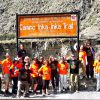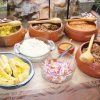Machu Picchu Location:
The Machu Picchu archaeological complex is located in the department of Cusco, in the Urubamba province and district of Machu Picchu. It is perched on the eastern slopes of the Vilcanota mountain range, a chain of mountains condensed by the Apurimac and Urubamba Rivers (great white water rafting!).
Hours of Operation:
Machu Picchu is open from 6:30 am to 5:30 pm (last admission at 4:00 pm).
Where you´ll stay:
Machu Picchu is located at the top of a small mountain next to the village called Aguas Calientes ¨hot waters¨. All available hotels except for the Sanctuary Lodge are located in this village.
From Aguas Calientes to the Citadel:
You can reach the Machu Picchu citadel on foot which takes about 45 minutes-1 hour and a half if you take it slow and includes a steep set of stone stairs. This hike is about 9km (5.5 miles) and is considered a moderately challenging trek that is suitable for anyone in reasonable physical shape. If you want to be one of the first to enjoy Machu Picchu, you should begin your hike by 4:00 am. On the bright side, the trek down is much easier and quicker! The other option is to take the bus from Aguas Calientes. The buses run every 15 minutes from 6:00 am until 4:30 pm, which the last bus back to the village at 5:30 pm. If you are starting your day bright and early, you should wait at the bus station by 4:00 am, as the lines get ridiculously long!
Altitude:
Much to one´s surprise, Machu Picchu actually lies at a lower elevation than Cusco!. Machu Picchu is situated at 2,340 meters (7,940 feet), while Cusco is at 3,399 meters (11,150 feet). Considering this, it is a good idea to go to Machu Picchu during the first days of your trip and save higher elevation excursions for later!. To avoid altitude sickness, it is encouraged to drink plenty of water as well as chew on coca leaves or drink the delicious, authentic mate de coca. Luckily, altitude sickness does not affect everyone- you could be lucky!
Weather:
Machu Picchu is located in a subtropical zone, so the climate is generally warm and humid throughout the day and cools at night. Temperatures range between 11 and 27 degrees Celsius (52 and 81 Fahrenheit). This zone is typically rainy, especially between November and March.
Best Times to Visit:
The ideal time to visit Machu Picchu is from May to September. During this time, it rains very little in the Andean region. Although it is winter, the temperatures in the Cusco, Sacred Valley, and Machu Picchu do not fluctuate much during the day.
The second best time to visit would be in March, April, October, or November. During these months, there may be some rain, but also may get lucky with uninterrupted sunny days. The months to avoid are December, January, and especially February and early March due to high rain levels.
Languages:
The languages spoken in this area are Spanish (Castellano) and Quechua, the traditional language of the Incas.
How do I get there?
There are two ways to get to Machu Picchu:
- Your first option is to travel by train. It takes 4 hours from the Cusco Poroy Station and 2 hours from the Ollantaytambo Station.
- Your second option is Adventure Trekking via the Inca Trail ¨Caminos Del Inca¨ which is a 4-day trek to Machu Picchu.
Hot Springs:
At a distance of 800 meters (about half a mile) from Aguas Calientes (Machu Picchu Pueblo), you can treat yourself to the underground hot sulfur springs which bubble up from the rocky ground at varying temperatures. The pools built at this resort are used as hot mineral baths at a temperature of 38-46 degrees Celsius (100-114 degrees Fahrenheit). This is an excellent way to rejuvenate after all the rigorous hikes!
Climbing Huayna Picchu:
Huayna Picchu is the towering mountain behind the actual site of Machu Picchu famously seen in all photographs. You´ll need a separate ticket to climb this peak at the site and you´ll need to book in advance (about a month), as there are a limited number of tickets. The view of looking down to admire Machu Picchu is undoubtedly a highlight for many, but be aware that some sections of this strenuous trail are quite narrow and steep. You will have the opportunity to start your climb at 7 am or 10 am. If you go at 10 am, there´s a better chance that the clouds will have lifted by then.
Some Interesting Facts:
- In Quechua, Machu Picchu means ¨old peak¨.
- Machu Picchu is made up of more than 150 buildings ranging from baths and houses to temples and sanctuaries.
- The compound is composed of more than 100 flights of stairs. Most of the individual staircases were carved from one single slab of stone.
- Although many of the stones that were used to build the city were more than 50 pounds. It is believed that no wheels were used to transport these rocks up the mountain. Rather, they suppose that hundreds of men pushed the heavy rocks up the steep mountainside! Incredible, eh?
- Many different theories exist about Machu Picchu- a royal estate or a secret ceremonial spot among them.
- Machu Picchu was only known by the local people until Yale Professor Hiram Bingham re-discovered the site in 1911. His book, The Lost City of the Incas, is based on his findings. (Recommendable read!)
- A long-lasting dispute between Peru and Yale University has existed over the artifacts collected by Bingham during his exploration of the site. Yale upholds that they own the items while Peru insists they were given on loan.
- Machu Picchu was an astronomical observatory, and its sacred Intihuatana stone accurately indicates the two equinoxes. Twice a year, the sun sits directly over the stone creating no shadow.
- The Incas were some of the best masons in the world. The structures were so well built with a technique called ashlar (stones that are cut to fit together without mortar) that not even a knife blade can fit in between stones.
- Unfortunately, most cities built by the Inca civilization were destroyed by the Spanish conquest. Machu Picchu was in a hidden location—invisible from below—and not found, making it one of the most well-preserved Inca cities and an archeological gem!
Social media:


















